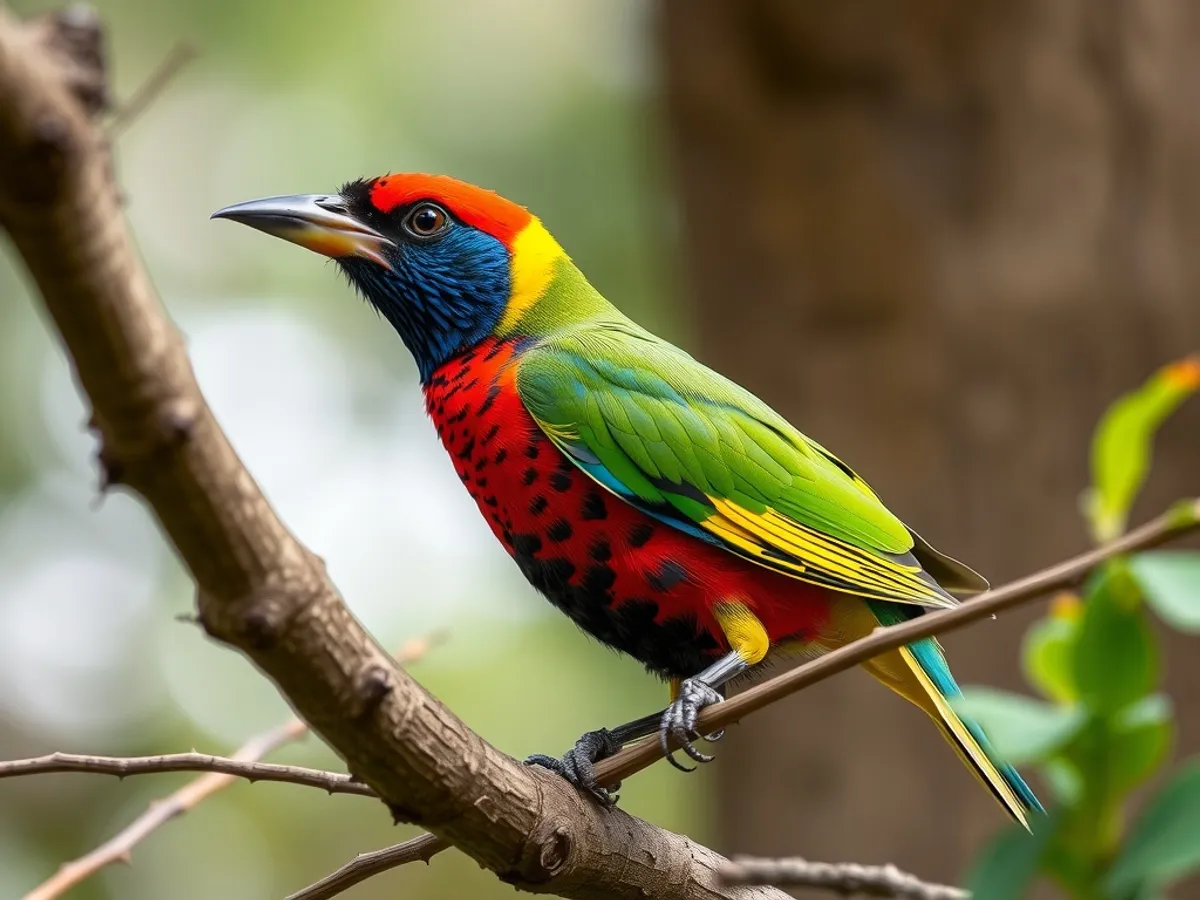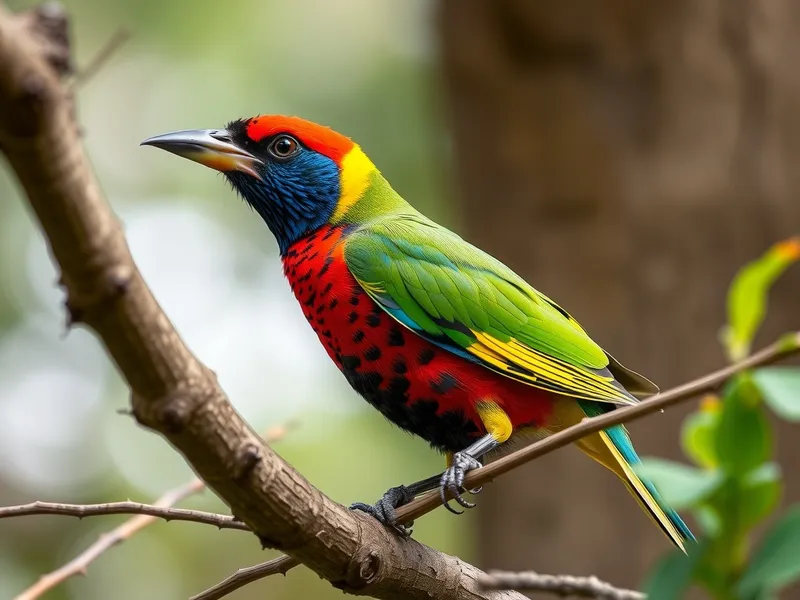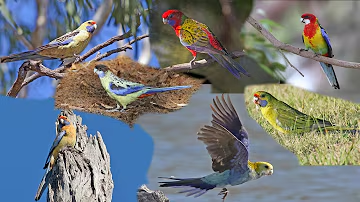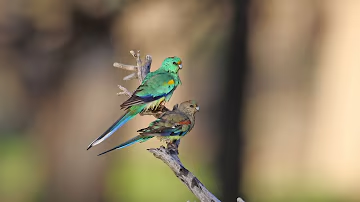
Eastern Rosella
Platycercus eximius

Meet the Eastern Rosella
The Eastern Rosella is a brightly colored parrot native to southeastern Australia and Tasmania. It is easily recognized by its vivid red head and chest, yellow underparts, and a distinctive white cheek patch, with green, blue, and black patterning on its back and wings. This medium-sized bird is often found in open woodlands, gardens, and parks, where it is known for its melodious calls and acrobatic flight. Eastern Rosellas are social, often seen in pairs or small flocks, and nest in tree hollows. They play a crucial role in their ecosystems as seed dispersers and pollinators.
Classification
Bird
Habitat
Open woodlands, forests, grasslands, and suburban areas
Diet
Omnivore
Lifespan
15-20 years
Conservation
Least Concern
Weight
90-120 grams
📖Fascinating Facts
Brilliant Plumage
Eastern Rosellas have striking multicolored feathers, with each bird displaying a unique pattern that helps with individual recognition.
Tree Hollow Nesters
They prefer to nest in tree hollows, often several meters above the ground, which provides safety from predators.
Melodious Calls
Eastern Rosellas communicate with a variety of calls, including whistles and chattering, and can even mimic certain sounds from their environment.
📋Detailed Description
The Eastern Rosella (Platycercus eximius) is a medium-sized parrot, measuring 29–33 cm (11–13 in) in length and weighing approximately 90–120 grams. Its plumage is strikingly colorful: the head and upper breast are bright crimson, the cheeks are white, the abdomen is yellow, and the back and wings display a scalloped pattern of black edged with yellow-green, with blue highlights on the wings and tail. Sexual dimorphism is subtle, with females generally duller and slightly smaller than males. The bill is pale and robust, adapted for cracking seeds, and the legs are grey. Eastern Rosellas exhibit a swift, undulating flight and are highly agile, often seen perching conspicuously or feeding on the ground. Their vocalizations include a series of melodic whistles and chattering calls, used for communication and territory defense. Socially, they are often observed in pairs or small flocks, particularly outside the breeding season. Nesting occurs in tree hollows, where they show strong site fidelity. Their diet is varied, including seeds, fruits, flowers, nectar, and insects, making them important agents of seed dispersal and pollination within their habitats.
💡 Did you know?
Despite their bright colors, Eastern Rosellas can be surprisingly difficult to spot in the wild due to their ability to blend into dappled sunlight among foliage.
🔬Research & Sources
Wikipedia Summary
The eastern rosella is a parrot native and endemic to south-eastern Australia. It was first introduced to New Zealand in cages, which then both intentionally released and accidentally escaped into the wild and has been found establishing mainly in the North Island and in the hills around Dunedin in the South Island since the early 20th century.
Last Modified: 5/29/2025
🎭Behavior & Social Structure
Eastern Rosellas are diurnal and spend much of their day foraging, primarily on the ground or in low vegetation. They exhibit a preference for open habitats, such as grassy woodlands, farmlands, and urban parks, where they search for seeds of native grasses, herbs, and introduced weeds. Feeding is often conducted in small, loose groups, with individuals maintaining a degree of vigilance for predators. During feeding, they use their strong beaks to husk seeds and their dexterous feet to manipulate food items. Social interactions include mutual preening, especially between mated pairs, and a range of vocalizations for contact, alarm, and courtship. Outside the breeding season, they may form larger flocks, sometimes mixing with other parrot species. Roosting typically occurs in dense foliage or tree hollows. Territorial behavior is most pronounced during the breeding season, with pairs defending nest sites against conspecifics and other cavity-nesting birds.
👶Reproduction & Life Cycle
Eastern Rosellas are monogamous, forming long-term pair bonds. The breeding season in Australia generally spans from August to February, though timing can vary with local climate. Courtship involves mutual feeding and display flights. Nests are established in natural tree hollows, often 1–6 meters above ground, but they may also use artificial nest boxes. The female lays 4–9 white eggs, which she incubates alone for about 19–21 days, while the male provides food. After hatching, both parents feed the chicks, which fledge at around 5 weeks old. Fledglings remain dependent on parents for several weeks post-fledging. Reproductive success is influenced by availability of suitable nesting sites and food resources.
🛡️Adaptations & Survival
Eastern Rosellas possess several adaptations for survival in variable environments. Their strong, curved beaks are specialized for cracking hard seeds and accessing a wide range of plant foods. Zygodactyl feet (two toes forward, two backward) provide excellent grip for climbing and manipulating food. Bright plumage may function in mate selection and species recognition, while their cryptic scalloped back pattern offers camouflage when perched among foliage. Behavioral flexibility allows them to exploit both natural and anthropogenic habitats, including urban gardens. Their ability to nest in a variety of tree hollows, including those in modified landscapes, enhances reproductive success. Seasonal flocking reduces predation risk and increases foraging efficiency.
📚Research Sources
🎨Cultural Significance
Eastern Rosellas hold a prominent place in Australian culture, frequently depicted in indigenous art and folklore as symbols of beauty and vitality. Their vibrant colors and melodious calls have made them popular in aviculture worldwide, though this has led to concerns about illegal trade. In New Zealand, their introduction has sparked debate over their impact on native bird species and ecosystems. The species is often featured in educational materials and birdwatching guides, serving as an ambassador for urban wildlife appreciation.
🔬Recent Research & Discoveries
Recent research has focused on the genetic diversity among Eastern Rosella subspecies, particularly the differentiation between mainland and Tasmanian populations (P. e. diemenensis). Studies using mitochondrial DNA have clarified phylogenetic relationships within the Platycercus genus. Ongoing ecological research examines their role in seed dispersal and pollination, as well as their adaptability to urban environments. Behavioral studies have documented complex vocal repertoires and social learning in foraging and nesting. Conservation research is investigating the effects of competition for nest sites and the potential for hybridization with other rosella species in areas of range overlap.
🎥Wildlife Videos

Rosella in the wild
Amazing Birds in the wild of Australia. There a 6 species of Rosella in Australia each one spectacular in its own way. Here we take ...
Plumes of Oz

Eastern Rosellas: Australia's Colorful Aviators - A Documentary on Nature's Artistry
Eastern Rosellas: Australia's Colorful Aviators - A Documentary on Nature's Artistry Discover the enchanting world of Eastern ...
Visual Wonders HD

EASTERN ROSELLA | Native Parrot | Short Australian Birdlife Documentary | Nature Exposed | EP16, S3
In this short informative episode we take a closer look at the Eastern Rosella. Arguably the prettiest of the 6 species of Rosella's ...
Nature Exposed

Australian parrots in the wild
This video is for those wanting to know about Australian Parrots in the wild with emphasis on what they eat. The parrots are ...
Plumes of Oz

Australia's Eastern Rosella
BIBY TV

Eastern Rosella in the wild
Eastern Rosella high up an old gumtree by the Campaspe River Echuca.
Zoe Watson
🌍Habitat Information
The Eastern Rosella typically inhabits Open woodlands, forests, grasslands, and suburban areas environments. Eastern Rosellas have adapted to their environments with specialized features and behaviors.
Primary Habitat:
Open woodlands, forests, grasslands, and suburban areas
More detailed habitat information will be available soon.
🛡️Conservation Status
The Eastern Rosella is currently classified as Least Concern. Conservation efforts are crucial for preserving this species for future generations.
Common Threats:
- 🏠Habitat loss and fragmentation
- 🌡️Climate change impacts
- 🎯Hunting and poaching
- 🏭Human-wildlife conflict
⚠️Threats & Conservation Challenges
Currently, the Eastern Rosella is classified as Least Concern by the IUCN, with stable populations across its native and introduced ranges. However, habitat loss due to land clearing, competition for nesting sites with invasive species (such as Common Starlings and feral honeybees), and illegal trapping for the pet trade pose localized threats. In some agricultural areas, they may be considered pests due to crop foraging. Urbanization has paradoxically benefited the species by providing new foraging and nesting opportunities. Long-term monitoring is needed to assess the impact of climate change on their distribution and breeding success.
🔬Scientific Classification
Scientific Name
Platycercus eximius
Classification Hierarchy
🔍 About Taxonomic Classification
Taxonomic classification is a hierarchical system used by scientists to classify and organize living organisms based on shared characteristics and evolutionary relationships.
The system moves from broad categories (Kingdom) to increasingly specific ones, with each animal's scientific name typically consisting of its Genus and species.
📝Community Notes
Share your observations and insights about the Eastern Rosella with our community of wildlife enthusiasts.
Join Our Community
Sign in to share your observations and connect with fellow wildlife enthusiasts.
Sign In to ContributeNo community notes yet
Be the first to share your observations about the Eastern Rosella!
Explore Eastern Rosella
Select a tab above to learn more about this amazing animal.
📸Photo Gallery
No photos available for this animal yet.
🌟Discover More Wildlife
Continue your journey of discovery with more fascinating animals from our database
